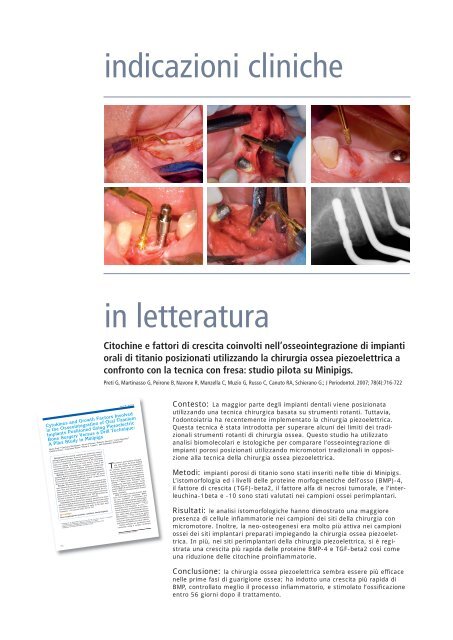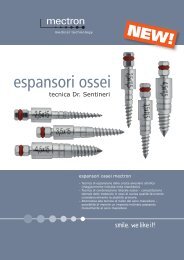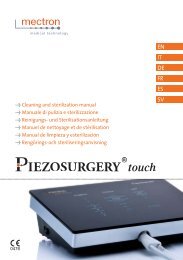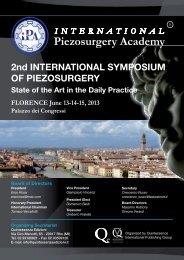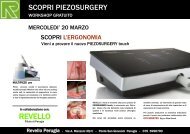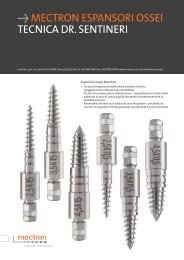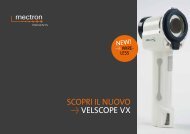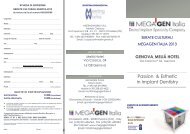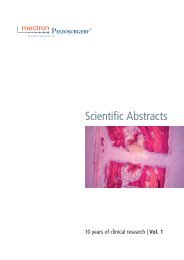Protocollo clinico per la preparazione del sito implantare ... - Mectron
Protocollo clinico per la preparazione del sito implantare ... - Mectron
Protocollo clinico per la preparazione del sito implantare ... - Mectron
You also want an ePaper? Increase the reach of your titles
YUMPU automatically turns print PDFs into web optimized ePapers that Google loves.
Cytokines and Growth Factors Involved<br />
in the Osseointegration of Oral Titanium<br />
Imp<strong>la</strong>nts Positioned Using Piezoelectric<br />
Bone Surgery Versus a Drill Technique:<br />
A Pilot Study in Minipigs<br />
Giulio Preti,* Germana Martinasso, † Bruno Peirone, ‡ Roberto Navone,* Carlo Manzel<strong>la</strong>,*<br />
Giuliana Muzio, † Crescenzo Russo,* Rosa A. Canuto, † and Gianmario Schierano*<br />
Background: Most dental imp<strong>la</strong>nts are positioned using a<br />
drilling surgery technique. However, dentistry recently ex<strong>per</strong>ienced<br />
the implementation of piezoelectric surgery. This technique<br />
was introduced to overcome some of the limitations<br />
involving rotating instruments in bone surgery. This study<br />
used biomolecu<strong>la</strong>r and histologic analyses to compare the<br />
osseointegration of porous imp<strong>la</strong>nts positioned using traditional<br />
drills versus the piezoelectric bone surgery technique.<br />
Methods: Porous titanium imp<strong>la</strong>nts were inserted into minipig<br />
tibias. Histomorphology and levels of bone morphogenetic<br />
protein (BMP)-4, transforming growth factor (TGF)-b2, tumor<br />
necrosis factor-alpha, and interleukin-1b and -10 were evaluated<br />
in the <strong>per</strong>i-imp<strong>la</strong>nt osseous samples.<br />
Results: Histomorphological analyses demonstrated that<br />
more inf<strong>la</strong>mmatory cells were present in samples from drilled<br />
sites. Also, neo-osteogenesis was consistently more active in<br />
bone samples from the imp<strong>la</strong>nt sites that were prepared using<br />
piezoelectric bone surgery. Moreover, bone around the imp<strong>la</strong>nts<br />
treated with the piezoelectric bone surgery technique<br />
showed an earlier increase in BMP-4 and TGF-b2 proteins as<br />
well as a reduction in proinf<strong>la</strong>mmatory cytokines.<br />
Conclusion: Piezoelectric bone surgery appears to be more<br />
efficient in the first phases of bone healing; it induced an earlier<br />
increase in BMPs, controlled the inf<strong>la</strong>mmatory process better,<br />
and stimu<strong>la</strong>ted bone remo<strong>del</strong>ing as early as 56 days posttreatment.<br />
J Periodontol 2007;78:716-722.<br />
KEY WORDS<br />
Bone morphogenetic proteins; cytokines; dental imp<strong>la</strong>nts.<br />
in letteratura<br />
Preti G, Martinasso G, Peirone B, Navone R, Manzel<strong>la</strong> C, Muzio G, Russo C, Canuto RA, Schierano G.; J Periodontol. 2007; 78(4):716-722<br />
T<br />
* Department of Biomedical Sciences and Human Oncology, Section of Prosthetic<br />
Dentistry, School of Dentistry, University of Turin, Turin, Italy.<br />
† Department of Ex<strong>per</strong>imentalMedicine and Oncology, University of Turin.<br />
‡ Department of Animal Pathology, University of Turin.<br />
716<br />
indicazioni cliniche<br />
Citochine e fattori di crescita coinvolti nell’osseointegrazione di impianti<br />
orali di titanio posizionati utilizzando <strong>la</strong> chirurgia ossea piezoelettrica a<br />
confronto con <strong>la</strong> tecnica con fresa: studio pilota su Minipigs.<br />
Volume 78 Number 4<br />
o enhance <strong>per</strong>i-imp<strong>la</strong>nt osteogenesis<br />
and reduce the bone healing<br />
time after imp<strong>la</strong>nt site preparation,<br />
the biologic factors that are involved<br />
in these processes must be evaluated.<br />
Literature supports the hypothesis that a<br />
porous imp<strong>la</strong>nt surface is more effective<br />
in stimu<strong>la</strong>ting <strong>per</strong>i-imp<strong>la</strong>nt osteogenesis<br />
than is a machined one using traditional<br />
drilling. 1-5 When bone formation was<br />
evaluated by histologic analysis, 5 levels<br />
of biologic factors, bone morphogenetic<br />
protein (BMP)-4 and transforming growth<br />
factor (TGF)-b, increased earlier around<br />
porous imp<strong>la</strong>nts.<br />
BMP-4 contains several proteins that<br />
have bone-inducing capacities. BMPs<br />
are key regu<strong>la</strong>tors of osteob<strong>la</strong>st and<br />
chondrocyte differentiation during skeletal<br />
development and of osteogenic differentiation<br />
in healing fractures. 6-9 TGF-b<br />
stimu<strong>la</strong>ted bone formation in vivo, 10,11<br />
which may have resulted from the stimu<strong>la</strong>ted<br />
proliferation of osteob<strong>la</strong>st precursors<br />
rather than stimu<strong>la</strong>ted osteob<strong>la</strong>stic<br />
differentiation. 12 Thus, it may be postu<strong>la</strong>ted<br />
that TGF-b could stimu<strong>la</strong>te BMP activity<br />
in the early phases of bone healing,<br />
just before the BMPs exert their effects.<br />
Dental imp<strong>la</strong>nts are positioned most<br />
commonly using a surgery technique<br />
doi: 10.1902/jop.2007.060285<br />
Contesto: La maggior parte degli impianti dentali viene posizionata<br />
utilizzando una tecnica chirurgica basata su strumenti rotanti. Tuttavia,<br />
l’odontoiatria ha recentemente implementato <strong>la</strong> chirurgia piezoelettrica.<br />
Questa tecnica è stata introdotta <strong>per</strong> su<strong>per</strong>are alcuni dei limiti dei tradizionali<br />
strumenti rotanti di chirurgia ossea. Questo studio ha utilizzato<br />
analisi biomoleco<strong>la</strong>ri e istologiche <strong>per</strong> comparare l’osseointegrazione di<br />
impianti porosi posizionati utilizzando micromotori tradizionali in opposizione<br />
al<strong>la</strong> tecnica <strong>del</strong><strong>la</strong> chirurgia ossea piezoelettrica.<br />
Metodi: impianti porosi di titanio sono stati inseriti nelle tibie di Minipigs.<br />
L’istomorfologia ed i livelli <strong>del</strong>le proteine morfogenetiche <strong>del</strong>l’osso (BMP)-4,<br />
il fattore di crescita (TGF)-beta2, il fattore alfa di necrosi tumorale, e l’interleuchina-1beta<br />
e -10 sono stati valutati nei campioni ossei <strong>per</strong>imp<strong>la</strong>ntari.<br />
Risultati: le analisi istomorfologiche hanno dimostrato una maggiore<br />
presenza di cellule infiammatorie nei campioni dei siti <strong>del</strong><strong>la</strong> chirurgia con<br />
micromotore. Inoltre, <strong>la</strong> neo-osteogenesi era molto più attiva nei campioni<br />
ossei dei siti imp<strong>la</strong>ntari preparati impiegando <strong>la</strong> chirurgia ossea piezoelettrica.<br />
In più, nei siti <strong>per</strong>imp<strong>la</strong>ntari <strong>del</strong><strong>la</strong> chirurgia piezoelettrica, si è registrata<br />
una crescita più rapida <strong>del</strong>le proteine BMP-4 e TGF-beta2 così come<br />
una riduzione <strong>del</strong>le citochine proinfiammatorie.<br />
Conclusione: <strong>la</strong> chirurgia ossea piezoelettrica sembra essere più efficace<br />
nelle prime fasi di guarigione ossea; ha indotto una crescita più rapida di<br />
BMP, control<strong>la</strong>to meglio il processo infiammatorio, e stimo<strong>la</strong>to l’ossificazione<br />
entro 56 giorni dopo il trattamento.


